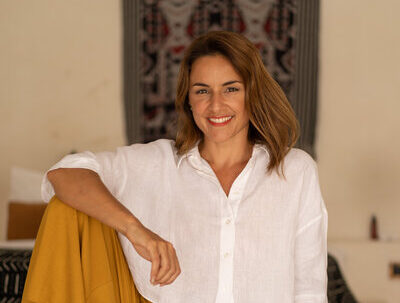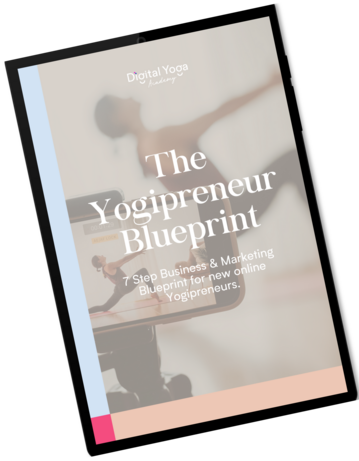Planning yoga retreats really takes a lot of work, time and energy. But hearing someone tell you that your retreat changed their life makes every effort totally worth it – and you know you’ve done a good job planning a retreat!
But how do you do a good job?
You have to do the groundwork and then plan, plan, plan! You have to give yourself enough time to craft an amazing experience for your retreaters.
Running yoga retreats is a really great addition to your offering. It’s a great way to build your business, your community and to bring more income to your business. It can also be a transformational experience for your students.
It can be quite easy to just dive straight in and get really excited about the fact you’re going to run a yoga retreat and start putting together an experience. But there are a few things that you need to do before you get into planning yoga retreats.
If you don’t do these things well then you will be making some mistakes.
I want to share with you three mistakes today that yoga teachers make when it comes to planning their retreat before the start of the planning process.
Avoiding these three mistakes will mean you have a solid foundation for your retreat planning process.
Planning yoga retreats mistake no 1: Not having the foundations in place
The first mistake to avoid when planning a retreat is not having a foundation in place.
What do I mean by that?
I mean your marketing foundations and there are four foundational pillars. They are your website, being visible on social media, email marketing and creating content. These foundational pillars are your base level to build your home on. You need to use these foundations to build an email list to collect details of your potential engaged students who could end up being your retreaters.
You can learn about these four pillars here: 4 Foundational Elements of Successful Online Yoga Business
If you don’t have these things in place, how can you successfully push out your message? How can you create a community that you’re going to sell your yoga retreat to?
You can’t.
When you start thinking about how to market a yoga retreat, you have to think about email list.
To build an email list make sure you have forms on your websites that will collect people’s email addresses. To do this effectively you need to have a free piece of content. This needs to be something valuable and related to yoga that your ideal student will be interested in and that you can offer to them in exchange for their email address.
Use every opportunity to collect email addresses including from the students in your classes.
Planning yoga retreats mistake no 2: Not understanding the costs of running a yoga retreat
The second mistake to avoid when planning yoga retreats is to not understand the costs.
Some people jump into how to run a yoga retreat and they look at how other yoga teachers are pricing their retreats and they pick a number. They then start pulling together their retreat and realise they’re not covering the costs.
Work out all of your retreat costs before you set the price of the retreat.
Do not just pluck a price out of thin air because it sounds good or we think that’s what our students will pay or because that’s what another yoga teacher charged for their retreat.
You need to know your costs!
This is a super important part of the planning process. All of your expenses need to be worked out before you can work what you’re going to charge students for the retreat.
So what are the main expenses when you think about how to run a yoga retreat?
The first one is the accommodation. If you booked a private villa, what is the cost to stay in that villa for a week or the number of days that you’re booking it for? If you’re working with a retreat centre, they will likely include the cost of the food and management and give you a cost per student.
Food is the next big cost, which may include the cost of flying a chef over from your home country.
Other costs include:
- flights
- yoga teacher pay
- chef pay
- team airport transfers
- team flights
- photographer / videographer
- gift bags
- on-site staff tips
- extra activities
- group travel during retreat (e.g to beach)
- your time!
- unexpected costs
It’s important not to forget the cost your own time spent on planning and think about how to market a yoga retreat.
You need to be super clear on all of these costs and also leave some room for unexpected expenses. I always keep a line in my budget for cash to cover unexpected things you need to get when you’re there.
Breaking even and making a profit
Once you have a clear idea of all your costs it’s only at that point you can start to figure out how many students you need to actually break even, which means to cover all the costs. Then you can work out how many students you need to make a profit, which will tell you how many students you need to make the retreat worthwhile for you. This is a very important step when you plan how to run a yoga retreat.
You have to think about your time and your energy and what is actually going to make this worthwhile for you.
You’re probably going to spend a lot of time here and you’re not going to get it straight away. You will have to play around with the numbers because you might find that you put in all of those costs against what you would potentially charge people and find you’re not making much profit.
So you may need to go back and reassess some of the lines in your budget. Maybe your venue is too expensive or maybe you need to change the activities that you’re offering.
Don’t forget to think about the overall value when it comes to pricing your retreat, because a lot of teachers, they price their retreats way to low. This might come from fear, especially if it’s the first time you’re doing a retreat. I know I can speak from experience with this.
What is your goal?
I’ve hosted 17 retreats in the last two and a half years and the first retreat that I ran was way under-priced. At the time that was okay for me because I was in the mindset of wanting to create content. My goal was to cover my costs and capture lots content to promote my next retreats.
So think about what your goal is as well but also don’t forget the bigger picture of the value that you’re offering your students. Your students are getting more than just yoga classes, a nice place to stay and some healthy food. They’re getting a chance to disconnect from whatever’s going on back home and it’s a chance for them to go through a period of healing and transformation.
Planning yoga retreats mistake no 3: Not understanding your ideal student
The final mistake is not understanding your ideal student and their wants and their needs.
Retreats are really exciting and we get really pumped up about it and dive straight into creating what we think our students want. We think we intuitively know what they want without actually asking them and most people don’t survey their students or ask for any feedback.
The ideal sweet spot is to create something you’re passionate about and that your students need and want right now!
When you’re really passionate about your offering and it’s in a location you love and you know your students also really want you’re offering and to go to that location, then you’re onto a winner.
My experience running retreats in Ibiza
I regularly run retreats in Ibiza, an island I’ve been visiting for over 20 years. Being able to promote my retreat in a place that I love, I can do it with so much more passion and share everything I know about the island and create experiences based on the best places and beaches that I’ve been to.
At the same time, I know my audience for my retreat business, Good Yoga Life, which is all about fun and balance and not taking yoga or yourself too seriously. I know that my community and my audience also want fun and adventure.
They want to be able to explore the island, enjoy themselves with a cocktail by the pool and have some wine with their dinner. I know I can create an experience that matches up with what my community wants as well.
To get this right, you have to ask your students and you need to do surveys. So before you get into the planning process you know what your students are after. You can use Survey Monkey to do this. It’s a really easy free online tool you can use to make surveys online.
Remember that this retreat is about them so make sure you ask them what they want.
Take the guesswork out of your decision making and planning
Otherwise, you’ll go with what you think your students want and you mind find that you’re not going to get people booking your retreat because what you think they want may not match with what they actually want.
On top of sending out surveys, you can also use the poll feature and question features on Instagram stories and in your Facebook group. Ask the question in an email to your list asking people to reply back and speak to your regular students after class.
Be persistent with it as you need to gather this feedback. You can give them an incentive, like a free class pass or a discount to an event. People are generally very busy and bombarded with messages every day and usually simply forget to respond. Usually, people don’t mind answering these questions so sending out reminders is fine.
Be mindful of these three easy mistakes to make if you jump headfirst into planning your retreat.
To summarise…
1. Get your marketing foundations in place, to begin with before you do anything.
2. Before you start planning how to run a yoga retreat look at all of your costs. Start playing with figures in a spreadsheet so you understand your budget and pricing.
3. Lastly, survey your students and get feedback about what they want from your retreat. This will help you how to market a yoga retreat in a way that resonates with your students.







